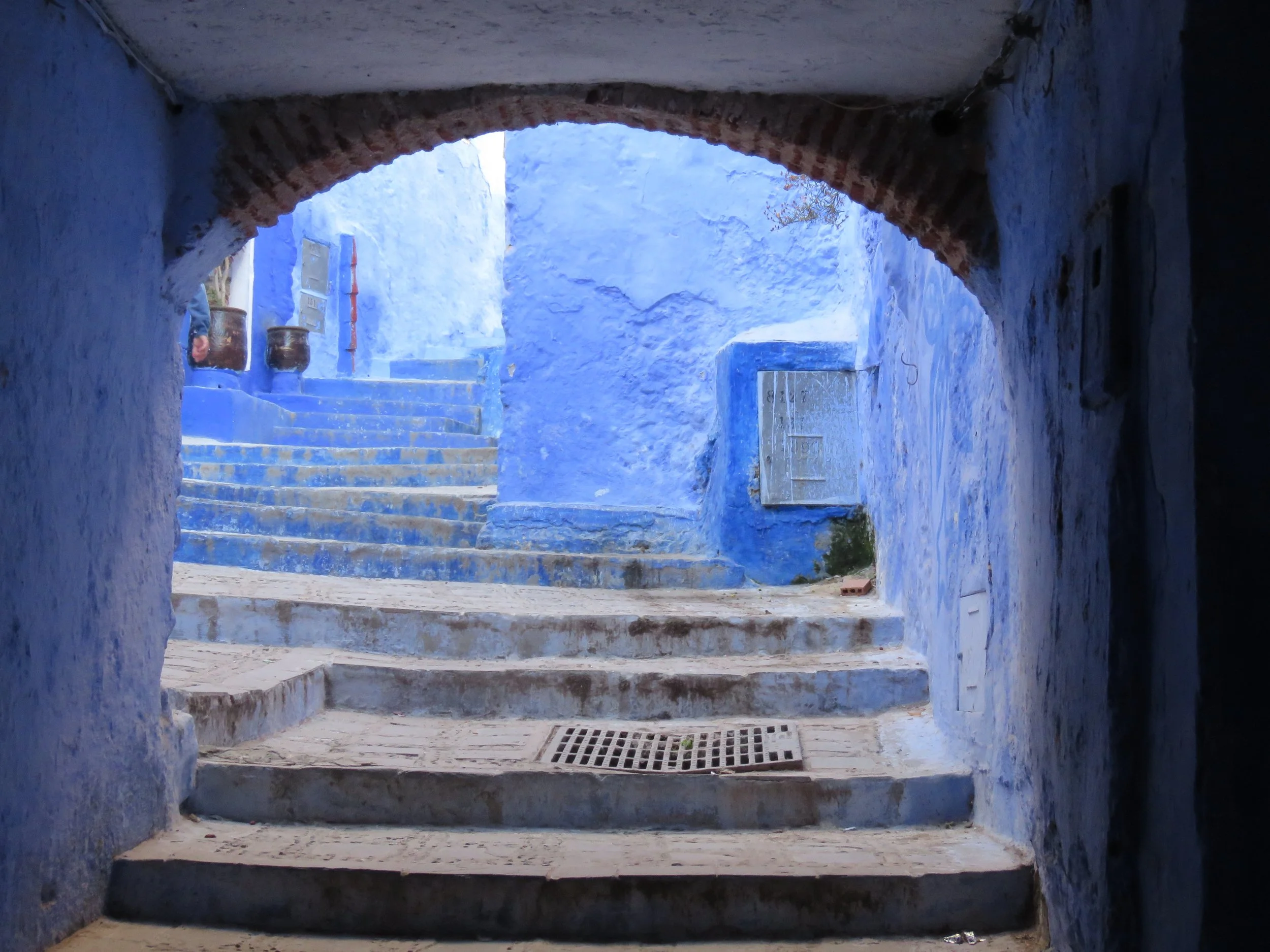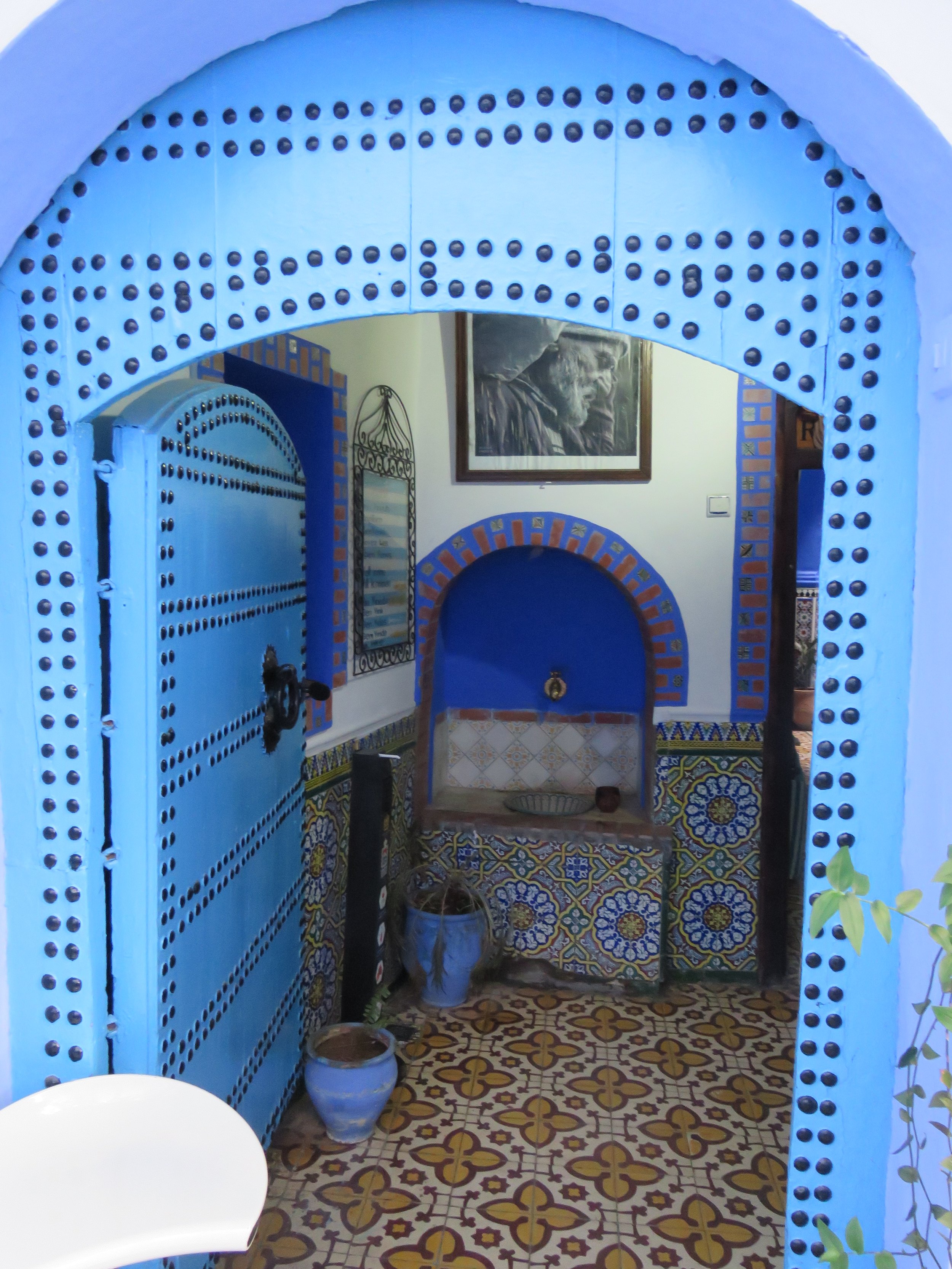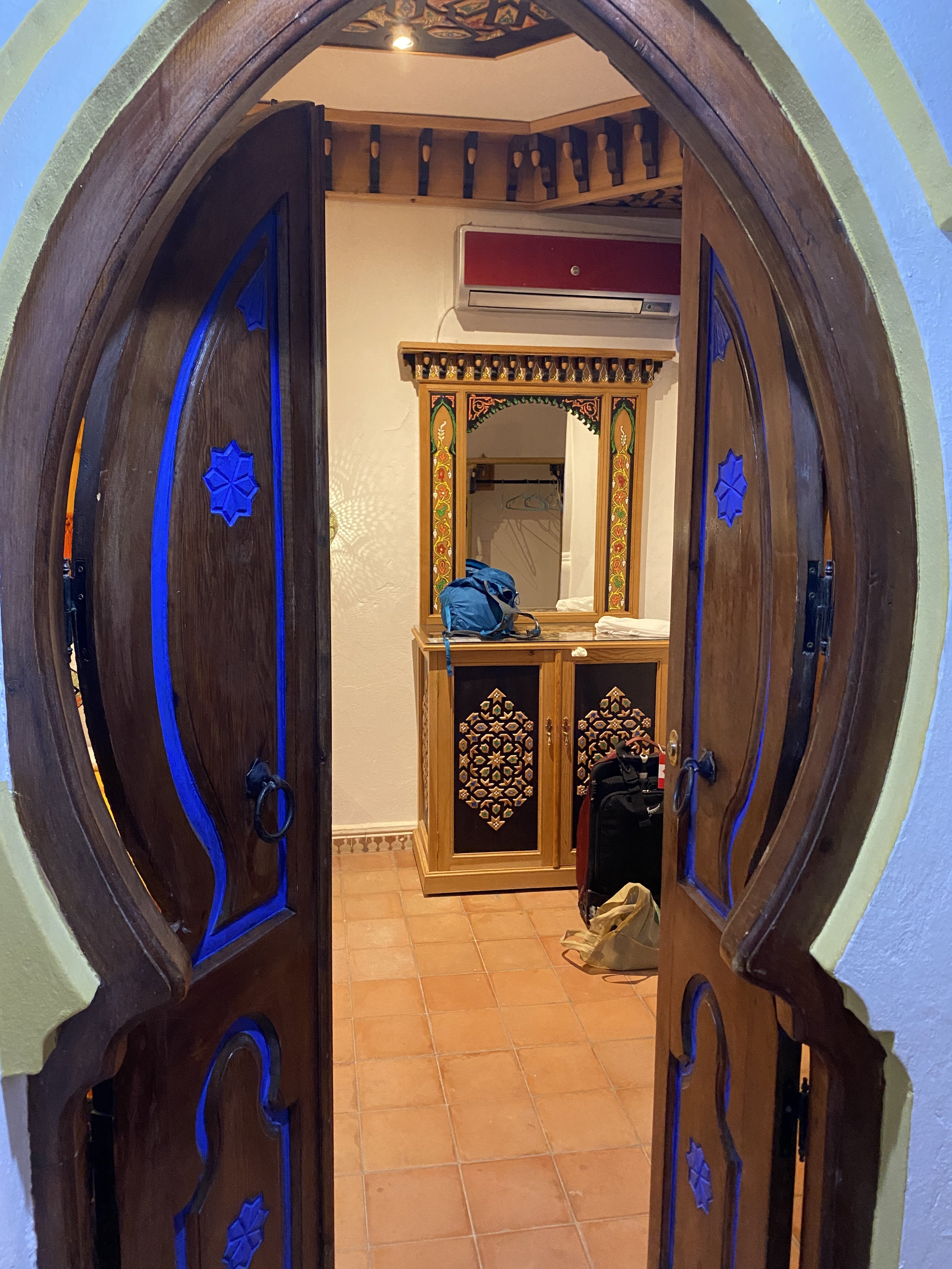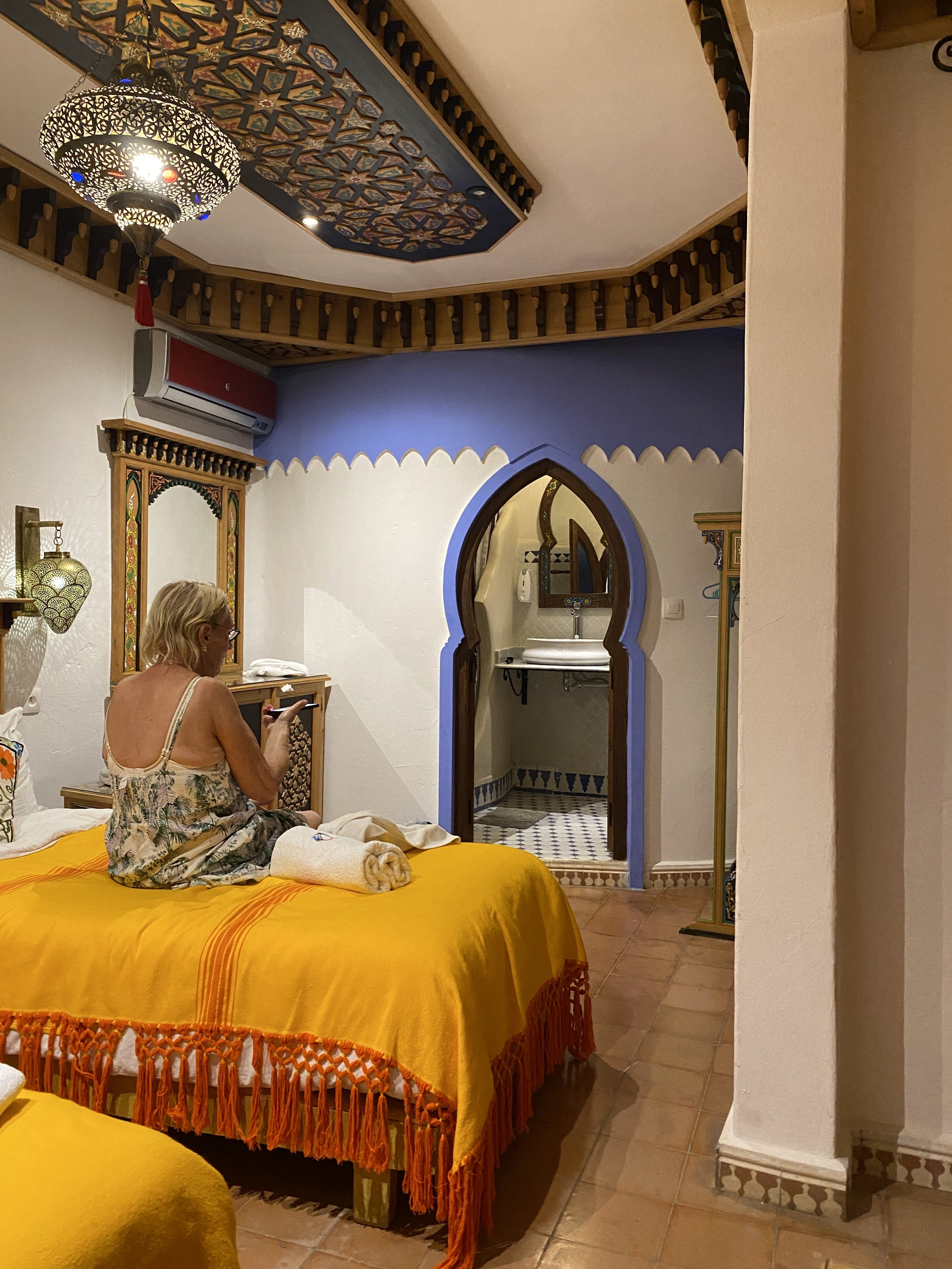On our trip exploring Morocco, we drove north from Fes, crossing the Rif Mountains. Rocky ridges of white stone had dry hillsides dotted with green farms. We’re told they grow a lot of opium here…We stopped at a roadside stand where we could buy calasbashes, woven baskets and bottled water. A young boy on his donkey stopped by to say hi.
Then we caught our first glimpse of Chefchaouen - Morocco’s blue city and one of the most magical cities I have ever seen… Even from a distance you notice a blue hue over the houses of this fairytale city.
We climbed up many of these blue-washed alleys to reach our riad.
We descended from the hills into the city and our van driver found a parking spot somewhere along a curb. Then we had to find our way, on foot, through the city gate and into the old city’s alleyways. No cars inside the medina. Just steep, steep cobblestone paths and staircases.
Climbing up through the narrow alleys, their stone walls lined with leather and weaving workshops selling clothes, purses, shoes and t-shirts, we arrived at our amazing little hotel. A traditional riad with courtyard plants and open walls. Our room looked… well, sort of like how I pictured Sheherazade living… We marvelled at the carved wooden ceilings and the shapely doorways.
Our riad’s front door, the door to our gorgeous bedroom… I wanted to stay here for… well maybe 1001 Nights!
The hotel was just steps from Chefchaouen’s main square - the Place Outa el Hammam. What a pictoresque place. I could have spend many more days here to explore and stroll around. Women in burka’s sat on the stone wall in the shade of a towering tree. Vendors sold ice creams and encouraged passerby’s to come in for lunch.
Outa el Hammam square with the Kashbah on the left.
Even the people wear blue.
Hanna and I walked to the square, found an ATM and sat sipping cold fruit juice while watching people parade by. On one side of the shady main square is the red-walled kasbah, a 15th-century fortress and dungeon. The kashbah is the oldest part of the medina, the original citadel founded in the late 15th century by Ali ibn Rashid. The fortress consists of a roughly rectangular enclosure protected by walls built in rammed earth.
I fit right in!
Chefchaouen was founded as a military base in 1471, shortly before the Spanish conquest of Granada. The city’s population grew quickly with an influx of Muslim and Jewish refugees fleeing here from Spain. The local culture is a wonderful mixture of Andalusian and Ghomara (a Berber tribe) people and their traditions.
Many Andalusian Muslims and Spanish and Portuguese Jews settled here during and after the Reconquista, when Spanish Christians conquered what remained of al-Andalus, the Muslim-controlled parts of the Iberian Peninsula. Morocco only gained its independence from Spanish colonial rule in 1956! Chefchaouen and most of the northern parts of the country were ceded by Spain that year.
The old walled city, or medina, is well-preserved while outside its protective walls a more modern city has sprung up - cars and motorbikes roaring by and buses bringing tourists. The economy is now driven by artisanal Berber crafts and tourism. Inside the medina it’s pretty quiet because of the lack of traffic.
My biggest question was “Why are the houses, doors, alleys, steps - everything - washed with a light to vibrant blue paint?” The answer was not straightforward. Some believe it came with the expelled Jews from Spain in the 1400’s - who believed blue was a heavenly colour.
Others are more prosaic, saying it might have been a mosquito deterrent. And others are even less romantic by saying that ‘it attracts tourists’.
But whether it repels mosquitoes or attracts tourists, one thing is for certain- the blue hues give the city some fascinating, mysterious fairytale feeling that I loved.
While sitting on the main square, watching life go by in many different shapes, sizes and languages, we noticed a rooftop patio high up on one of the tall narrow restaurants overlooking the square.
So that night we entered the front door of the restaurant and climbed up and up the many staircases. A first floor, a second floor… both full of neatly set tables but no people. A third floor with a wooden balcony. A few people sat out there. But we kept climbing and finally reached the roof top where tables were set and we had a magnificent view over the blue city. Join us on the rooftop by clicking on the video. Be sure to turn up your sound!
We could see part of the historic city wall spreading a protective arm around the old houses. The call to prayer floated up from the mosque’s minaret. And way down below we watched people walking along the square and, even further down, we spotted the foot bridge over the Fouara river.
Every night in Chefchaouen thousands stream out of town, cross the little river and climb the hillside toward the Spanish Mosque. The next night we joined them. The trail leads past rocky hillsides of prickly pear and agave cacti. The little white mosque was built by the Spanish for the local population, but it was never actually used. Climbing up the rocky path at night alongside hundreds of others felt exactly like that scene in Mama Mia when they all trudge up to the church on a steep rocky outcrop…. The sunset over the Rif Mountains was hazy and gently smudged the old city’s blues into greys.
The main plaza at night. The rooftop patio is on the blue & white building.
BOOKS - scroll down to Morocco.
The Donkeys of Morocco (article): https://www.smithsonianmag.com/travel/moroccos-extraordinary-donkeys-40973739/
REOURCES: https://www.visitmorocco.com/en/travel/chefchaouen
Our hotel here: https://www.guestreservations.com/hotel-dar-mounir












